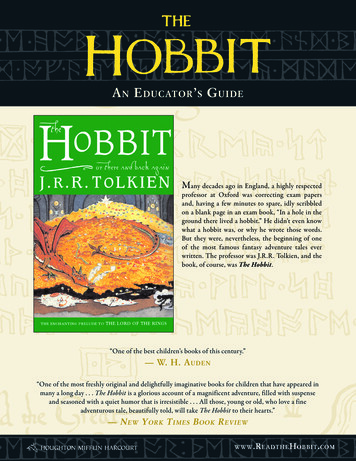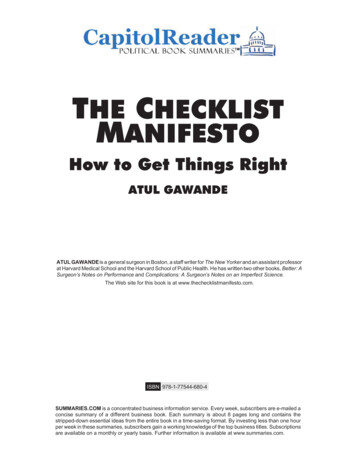
Transcription
A n E ducator ’ s G uideMany decades ago in England, a highly respectedprofessor at Oxford was correcting exam papersand, having a few minutes to spare, idly scribbledon a blank page in an exam book, “In a hole in theground there lived a hobbit.” He didn’t even knowwhat a hobbit was, or why he wrote those words.But they were, nevertheless, the beginning of oneof the most famous fantasy adventure tales everwritten. The professor was J.R.R. Tolkien, and thebook, of course, was The Hobbit.“One of the best children’s books of this century.”— W. H. A uden“One of the most freshly original and delightfully imaginative books for children that have appeared inmany a long day . . . The Hobbit is a glorious account of a magnificent adventure, filled with suspenseand seasoned with a quiet humor that is irresistible . . . All those, young or old, who love a fineadventurous tale, beautifully told, will take The Hobbit to their hearts.”— N ew Y ork T imes B ook R eviewwww .R eadthe H obbit . com
ABOUT THE BOOKBilbo Baggins is a hobbit who enjoys a comfortable, unambitious life, rarely traveling any farther than his pantryor cellar. But his contentment is disturbed when the wizard Gandalf and a company of dwarves arrive on his doorstep one day to whisk him away on an adventure. They have launched a plot to raid the treasure hoard guarded bySmaug the Magnificent, a large and very dangerous dragon. Bilbo reluctantly joins their quest, unaware that on hisjourney to the Lonely Mountain he will encounter both a magic ring and a frightening creature known as Gollum.PRE-READING ACTIVITIES Ask readers to share what they think are the essential elements of a great adventure story. Ask readers to share what they think are qualities that make a person heroic. Introduce readers to the archetypal elements of the classic hero’s journey.EXPLORING CHARACTER How does Tolkien reveal character in The Hobbit? Is Bilbo consistent in his actions? Is he a fully developed character? How? Why? How does Bilbo change and/or develop as a character over the course of the story? How does Bilbo relate to other characters in the book? Do you find the characters likable? Who are the characters and creatures in the story you would want to meet? What does Tolkien reveal about the goblins? Why do you think he chooses not to describetheir physical appearance? How are Bilbo and Gollum alike? What skills does Bilbo exhibit in how he deals with Gollum? What does Bilbo gain from his adventure? What is the difference in the way his home is dear to him atthe end of the story? Why doesn’t Bilbo tell the dwarves about his ring? Do you consider this lying? Why does Bilbo give up the Arkenstone? What does that gesture reveal about his character? Why does he return to the Mountain? Discuss Beorn’s character. Is he virtuous or vicious? Using the pattern of the mythic hero’s journey, trace the character development of Bilbo Baggins. Identify the following developments in the story: a call to adventure; a separation from the known world;initiation into a new world; threats to the successful achievement of the quest; the fellowship of close 2
companions; the guidance of a mentor; a descent into darkness; a rebirth or resurrection; and the transformedhero’s return to the old world. Although Bilbo, like all heroes of epic tales, sets out on a quest and faces and overcomes many obstacles,his heroism is not quite epic. In what ways is Bilbo a reluctant hero? What is heroic and not so heroic about Bilbo? How is Bilbo like or unlike contemporary questing heroesin movies and fantasy stories?EXPLORING CONFLICT What are examples of conflict in The Hobbit? What types of conflict (physical, moral, intellectual, oremotional) do you see?EXPLORING METAPHOR AND SYMBOLISM What are examples of symbolism in The Hobbit? How do they relate to the plot and characters?T he D ragon —In fantasy literature, dragons often serve as metaphors for greed. Readers may question, however, who is the real dragon: Smaug, or Thorin, or any of the elves and men who lust for the treasure beneath theLonely Mountain? Once Smaug is killed, the greed over the wealth he leaves behind turns what should be “thehappy ending” of this story into an occasion for war and violence and even betrayal.M irkwood F orest —Metaphorically, Mirkwood represents the mythic “descent into darkness,” throughwhich the hero faces a crisis or turning point and achieves greater self-knowledge. Bilbo kills spiders and beginsto feel braver than he did when entering the forest; it is just after Mirkwood, in the dungeons of the elf-king, thatBilbo, by himself, concocts a plan to rescue the imprisoned dwarves. He journeys to the metaphorical underworldand emerges a new person.T he S hire —On one level, the pastoral homeland of the hobbits is Tolkien’s idealized portrait of rustic, ruralEngland. It also symbolizes a withdrawn and insulated life. Bilbo leaves the Shire to engage the world and to findhis place in it. The Shire represents comfort and tranquility, not bad in and of themselves, but also not all thatconstitutes life. When Bilbo returns to the Shire, he is a more experienced and more knowledgeable person thanhe could have been had he stayed in the Shire forever. He learns to value the world outside; as his own song putsit, “The road goes ever on.” He also learns a lot about himself. There are always more journeys—outer as well asinner—to be taken, even at one’s own home. 3
EXPLORING MOTIFSAlthough Tolkien creates a unique imaginary world, he also borrows extensively from the traditional elements ofmyths, fairy tales, fables, and folk tales. Ask readers to compare Tolkien’s use of these motifs with the way theyare used in myths or fairy tales students are familiar with: wiseadvisers dwarves ,elves , trolls talkinganimals riddlesand runes magicobjects underworldsettings dragons s hape - shifters thetreasure trove theperilous journeyEXPLORING NARRATIVE Why is it important that Gandalf is not present when the expedition meets the trolls in chapter two? When, how, and why does the narrative tone of The Hobbit change? What is the role of fate in The Hobbit? Does the story end the way you expected? How? Why? In his book Secret Gardens: The Golden Age of Children’s Literature (Houghton Mifflin, 1985), HumphreyCarpenter calls The Hobbit “largely a sustained exploration of evil” (212). Explain why you agree or disagreewith his description.EXPLORING SETTING How essential is the setting to the story? Could the story have taken place anywhere else? How do the different settings in the story relate to plot, theme, and character development? 4
EXPLORING THEMESWhat are some themes in the story? How do they relate to the plot and characters?“M ore T han M eetstheE ye ” —How does this phrase summarize the experience of Bilbo Bagginsand Bilbo’s experience of himself ? Bilbo is an unlikely hero, but from the outset of the adventure Gandalfknows that the little hobbit has it within him to be more than even Bilbo imagines. Both the other characters’ growing knowledge of Bilbo, and Bilbo’s own deepening awareness of himself express the theme of selfknowledge that is at the heart of many mythic quest tales.G reedandP ride —The theme of the danger of too much pride and of greed is found throughout TheHobbit. Thorin, who loses much because of his stubborn commitment to ancestral pride and desire for hisfamily treasure, is a cautionary example. The broken relationships between men, elves, and dwarves at theend of the book warn readers of how greed and pride can damage the social fabric.M orality —Readers may want to consider the question of “What is moral?” in the context of The Hobbit.The hero of the story is a burglar who conceals the truth from his friends, doesn’t quite “play fair” in a riddlecontest, and steals the one part of the treasure that Thorin most desires. Do the ends always, or even often,justify the means? Is Bilbo consistently obeying a larger and greater good? How might the theme of moralityinteract with the theme of “More Than Meets the Eye”?E ngagementandW ithdrawal —The Hobbit raises the questions of how and when to engage withthe wider world. Tolkien presents Bilbo’s home in “Bag-End” as a quite comfortable place, but it is not thesum total of the “wide world” (as Gandalf phrases it) either. Like Bilbo, we all must discover our place in thewide world, even if it ends up being a “small” one.L earningfrom theP ast —The past is very much present in The Hobbit: for Thorin, for theWood-elves, for the Master and the people of Esgaroth, for Bard, and even for Bilbo, who must reconcilethe “Baggins” and “Took” sides of his personality. Readers can consider the questions: How aware am I of mypersonal and social history? Does that history affect me largely for good or for ill? To what extent should werespect and learn from the past, and to what extent should we let it be past?POST-READING ACTIVITIES One of the most memorable scenes in The Hobbit is the riddle competition between Bilbo and Gollum.Have students write riddles of their own using those in the story as frameworks and stage some competitions. Using the map of Wilderland at the end of the novel, have students work in pairs or small groups to create atourist guide or brochure. Create a song about Smaug using his description in the novel. Have students create an illustration of a favorite scene in the novel. Have students explore runic alphabets at Omniglot: The Online Encyclopedia of Writing Systemsand Languages, http://www.omniglot.com/writing/runic.htm. Have students use electronic and print resources to research the influences of Anglo-Saxon, Norse, otherEuropean mythologies, and Tolkien’s Roman Catholic beliefs on his writing. 5
SUGGESTIONS FOR FURTHER READINGBarron, T. A. Lost Years of Merlin series. Philomel.Cadnum, Michael. Raven of the Waves. Orchard, 2001.Crossley-Holland, Kevin. The Seeing Stone (Arthur Trilogy, Book 1). Scholastic/Arthur A.Levine, 2001.Crossley-Holland, Kevin. At the Crossing-Places (Arthur Trilogy, Book 2). Scholastic/Arthur A.Levine, 2002.Crossley-Holland, Kevin. King of the Middle March (Arthur Trilogy, Book 3). Scholastic/ArthurA. Levine, 2004.Crossley-Holland, Kevin. The Norse Myths. Pantheon, 1980.Morpurgo, Michael. Beowulf. Illus. Michael Foreman. Candlewick, 2006.Olsen, Corey. Exploring J.R.R. Tolkien’s “The Hobbit.” Houghton Mifflin Harcourt, 2012.Sutcliff, Rosemary. The Sword and the Circle. Puffin, 1994.Sutcliff, Rosemary. The Light Beyond the Forest. Puffin, 1994.Sutcliff, Rosemary. The Road to Camlann. Puffin, 1994.Tolkien, J.R.R. The Lord of the Rings. Houghton Mifflin Harcourt, 2005.Tolkien, J.R.R. The Silmarillion. Houghton Mifflin Harcourt, 2001.Tolkien, J.R.R. Sir Gawain and the Green Knight. Del Ray, 1979.White, T. H. The Once and Future King. Ace, 1996.ADDITIONAL RESOURCESBBC History: Anglo-Saxonswww.bbc.co.uk/history/ancient/anglo saxonsHoughton Mifflin Harcourtwww.readthehobbit.comThe Mythopoeic Societywww.mythsoc.orgThe Tolkien Professorwww.tolkienprofessor.comT he H obbitby J.R.R. Tolkien978-0-547-95383-0 Hardcover978-0-618-26030-0 Paperback978-0-547-95197-3 E-book978-0-547-95196-6 Enhanced e-bookVisit www.readthehobbit.com for more books by and aboutJ.R.R. Tolkien, biographical information, character guides, and more.Discussion guide written by Edward T. Sullivan, a freelance writer and librarian. 2012 Houghton Mifflin Harcourt. All rights reserved.www .R eadthe H obbit . com
book, of course, was The Hobbit. “One of the best children’s books of this century.” — w. h. auden “One of the most freshly original and delightfully imaginative books for children that have appeared in many a long day . . . The Hobbit is a glorious











